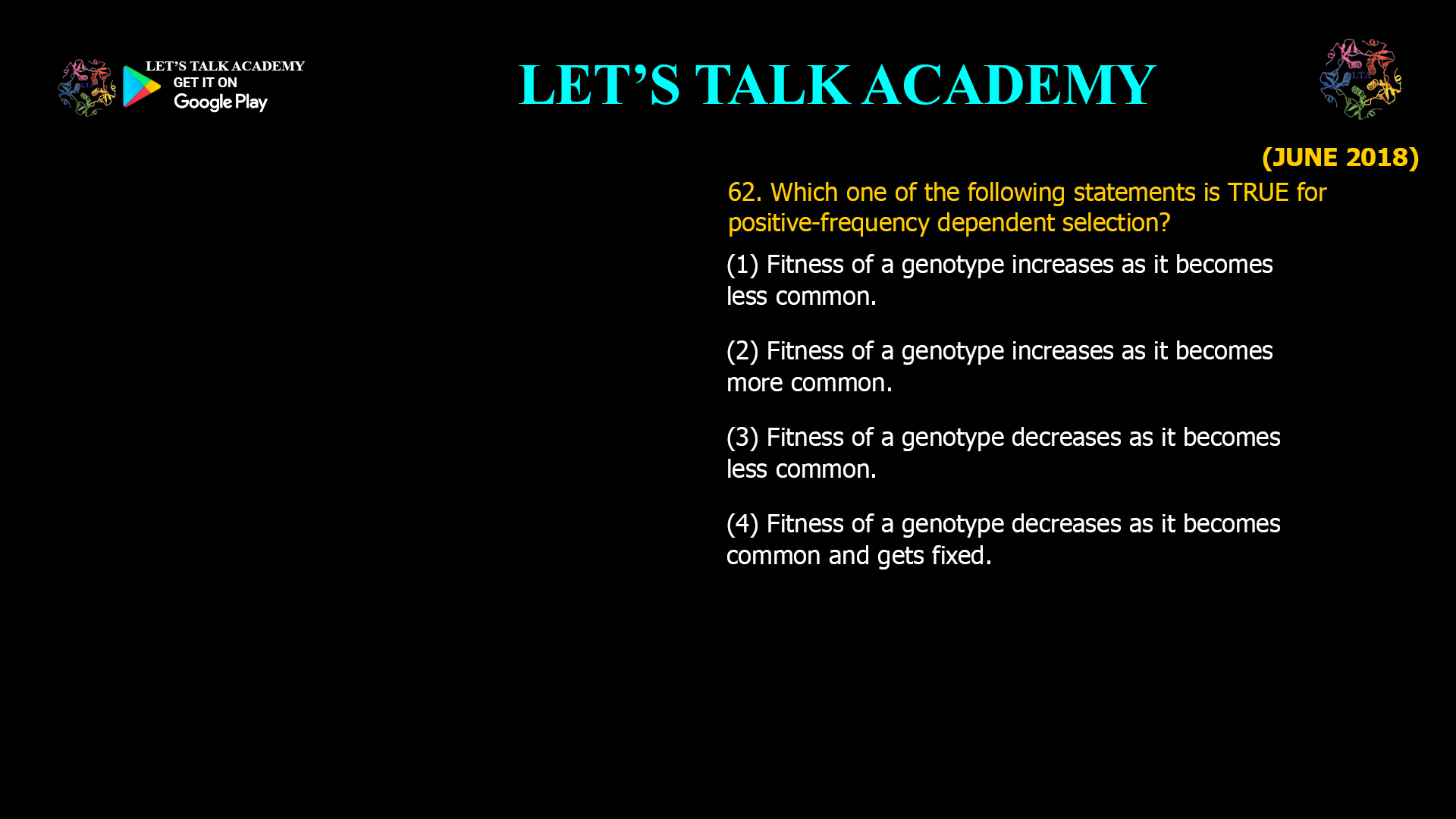- Which one of the following statements is TRUE for positive-frequency dependent selection?
(1) Fitness of a genotype increases as it becomes less common.
(2) Fitness of a genotype increases as it becomes more common.
(3) Fitness of a genotype decreases as it becomes less common.
(4) Fitness of a genotype decreases as it becomes common and gets fixed.What is Frequency-Dependent Selection?
Frequency-dependent selection is a form of natural selection in which the fitness of a phenotype or genotype depends on its frequency relative to other phenotypes or genotypes in a population. In other words, how common or rare a trait is can directly influence its success in the evolutionary race.
There are two primary forms:
-
Positive frequency-dependent selection: Fitness increases as a trait becomes more common.
-
Negative frequency-dependent selection: Fitness increases as a trait becomes rarer.
This article focuses on the former, which is crucial for understanding how certain traits can become dominant and even fixed in populations.
The Core Principle: Fitness Increases with Frequency
The defining characteristic of positive frequency-dependent selection is that the fitness of a genotype or phenotype increases as it becomes more common in the population. This means that the more individuals that share a particular trait, the greater the evolutionary advantage for those individuals.
Statement Option Description True/False for Positive Frequency-Dependent Selection (1) Fitness increases as genotype becomes less common False (2) Fitness increases as genotype becomes more common True (3) Fitness decreases as genotype becomes less common False (4) Fitness decreases as genotype becomes common and gets fixed False Thus, the correct statement is:
Fitness of a genotype increases as it becomes more common.How Does Positive Frequency-Dependent Selection Work?
In positive frequency-dependent selection, the advantage of a trait grows as it spreads through the population. This process can be explained as follows:
-
When rare: The trait offers little or no advantage, and may even be selected against.
-
As it becomes common: The trait’s advantage grows, leading to a snowball effect where more individuals with the trait survive and reproduce.
-
Potential outcome: The trait can become so common that it dominates the population, often reducing genetic diversity.
This type of selection tends to decrease genetic variance because it favors the most common phenotype, potentially leading to fixation of that trait.
Real-World Examples
Understanding positive frequency-dependent selection becomes clearer through real-world examples:
-
Müllerian Mimicry in Butterflies: In some butterfly species, all morphs are poisonous and share similar warning coloration. As a particular color pattern becomes more common, predators learn to avoid it, increasing the survival of individuals with that pattern. The more common the warning coloration, the greater the collective benefit for those sharing it.
-
Warning Coloration in Snakes: The scarlet kingsnake, a harmless species, mimics the coloration of the venomous coral snake. In regions where the coral snake is common, this mimicry is highly advantageous, as predators avoid both species. As the kingsnake’s coloration becomes more common, its fitness increases.
-
Signaling and Communication: In social animals, certain signals or behaviors become more effective as more individuals adopt them. For example, specific bird calls or mating displays may only be advantageous when widely recognized within a group.
Evolutionary Implications
Positive frequency-dependent selection has several important consequences:
-
Fixation of Traits: It can rapidly lead to the dominance or fixation of a particular trait, reducing genetic diversity in the population.
-
Vulnerability to Change: Populations dominated by a single trait may be less adaptable to environmental changes, as alternative traits are lost.
-
Unstable Equilibrium: If a rare trait tries to invade a population dominated by a common trait under positive frequency-dependent selection, it is typically selected against and quickly eliminated.
Contrasting Negative Frequency-Dependent Selection
It’s important to distinguish positive frequency-dependent selection from its counterpart:
Type Fitness Effect Impact on Diversity Positive Frequency-Dependent Fitness increases as trait becomes more common Decreases diversity Negative Frequency-Dependent Fitness increases as trait becomes rarer Maintains/increases diversity Negative frequency-dependent selection helps maintain polymorphism and genetic diversity, whereas positive frequency-dependent selection does the opposite.
Why Does Positive Frequency-Dependent Selection Matter?
This form of selection is fundamental in understanding:
-
Evolution of warning signals: Many anti-predator adaptations rely on positive frequency-dependent selection to be effective.
-
Spread of social behaviors: Cooperative or communicative behaviors often require a critical mass to be advantageous.
-
Population genetics: It explains why certain traits can become overwhelmingly common, sometimes to the detriment of the population’s adaptability.
Conclusion
Positive frequency-dependent selection is a powerful evolutionary force that favors traits as they become more common, leading to increased fitness for individuals sharing those traits. This process can quickly shape the genetic landscape of populations, driving certain traits to dominance and reducing genetic diversity. Understanding this mechanism is essential for anyone interested in evolutionary biology, population genetics, and the dynamics of natural selection.
-




1 Comment
Sonal Nagar
November 14, 2025Fitness of a genotype increases as it becomes more common.